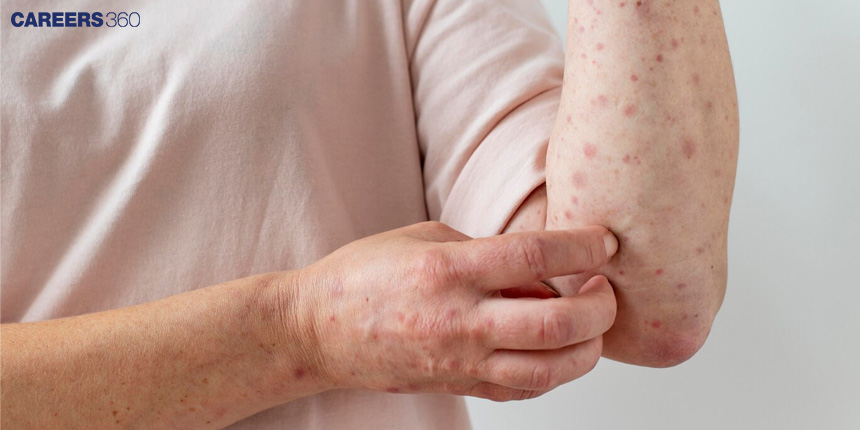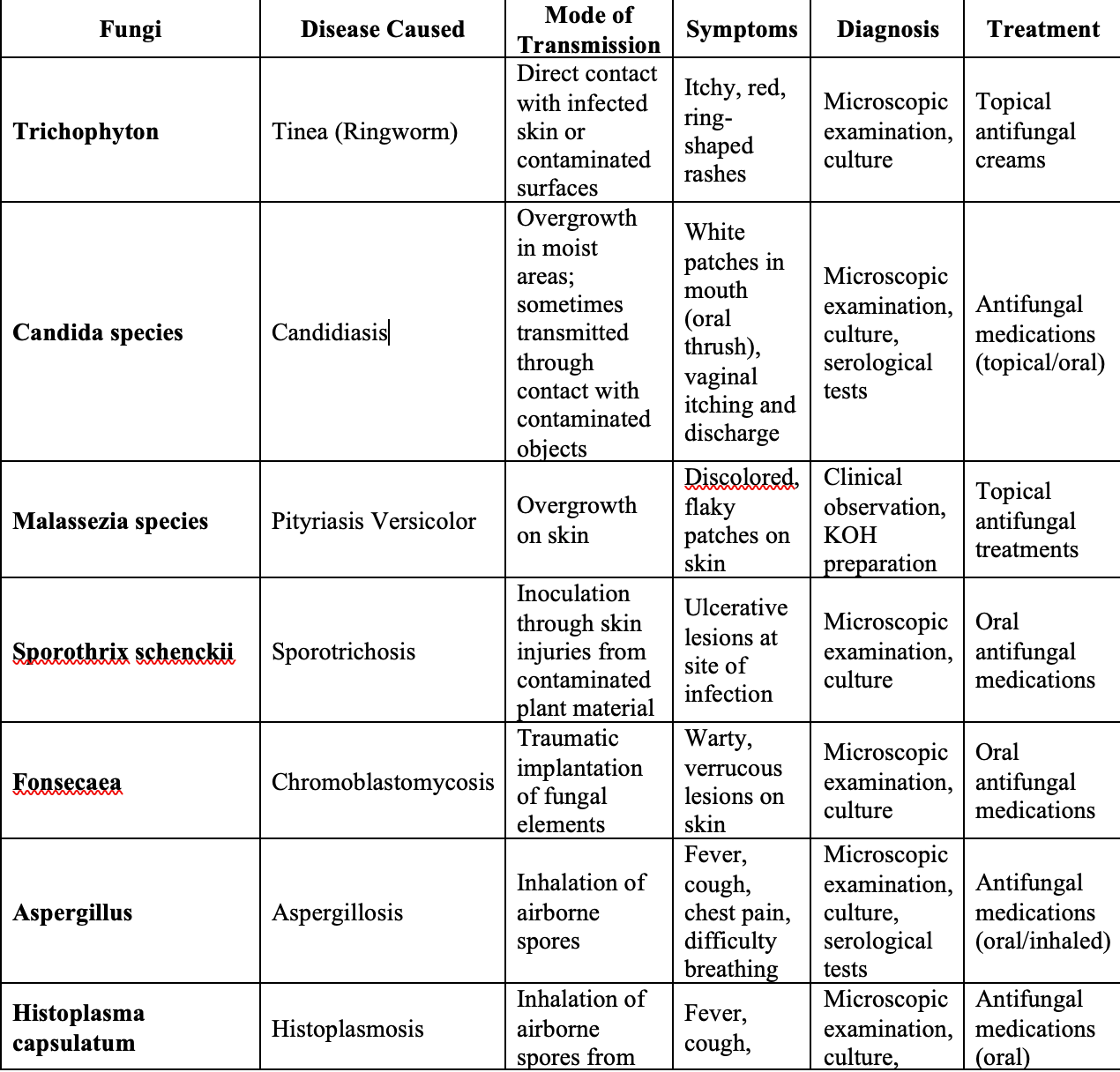Fungal Infections: Meaning, Types, Examples, Treatment, Symptoms
What are Fungal Infections?
Mycoses, or fungal infections, are diseases produced by fungi that can develop in the human body and its diverse regions. These infections can be normal as skin conditions or can advance to severe system diseases. HSA is significant in human health because some types of fungal infections lead to severe morbidity and, in some cases, mortality, most affecting immuno-compromised patients.
Don't Miss: Most scoring concepts for NEET | NEET papers with solutions
NEET 2025: Syllabus | PYQs | Crack NEET in 2 months - Study Plan
NEET Important PYQ & Solutions: Physics | Chemistry | Biology | NEET PYQ's (2015-24)
- What are Fungal Infections?
- What are Fungi?
- Classification of Fungi:
- Types of Fungal Infections
- Superficial Fungal Infections:
- Tinea (Ringworm)
- Candidiasis
- Pityriasis Versicolor
- Subcutaneous Fungal Infections:
- Sporotrichosis
- Chromoblastomycosis
- Systemic Fungal Infections:
- Aspergillosis
- Histoplasmosis
- Cryptococcosis
- Coccidioidomycosis (Valley Fever)
- What Causes Fungal Infections, and How Do They Spread?
- Diagnosis of Fungal Infections
- Treatment of Fungal Infections
- How Can I Lower My Risk of Fungal Infections?

What are Fungi?
The classification of fungi is as follows; yeasts, moulds and mushrooms all fall under the category of eukaryotic organisms. These animals/signs are rather important for carrying out several roles in ecological sequences in that they decompose organic matter and recycle nutrients. Nevertheless, there are pathogenic fungi that spread diseases to humans through spores or touching.
Classification of Fungi:
Yeasts: are a group of single-celled fungi with the ability to reproduce through a process called budding.
Moulds: are more complex and have branching, thread-like structures known as the hyphae.
Dimorphic Fungi: It is a fungus that, in some cases, may look like yeast, but under certain conditions, it can form moulds.
Types of Fungal Infections
Fungal infections can be classified into three main types: Superficial, Subcutaneous, and Systemic.
Superficial Fungal Infections:
These are skin, hair, and nail infections.
Tinea (Ringworm)
Causative Agents: Sporulating fungi are: Dermatophytes such as Trichophyton, Microsporum and Epidermophyton.
Symptoms: yellow, scaly, ring-shaped rashes.
Diagnosis and Treatment: This is done through the conditions presented during clinical examination and through a minute examination of skin scrapings; it is cured through the use of topical antifungal drugs such as clotrimazole or oral antifungal drugs such as terbinafine
Candidiasis
Causative Agent: These include Candida species.
Types: Some of the common conditions include Oral thrush and vaginal yeast infection.
Symptoms: Coatings of white in the mouth; stinging; and secretion in vaginal infections.
Diagnosis and Treatment: Its diagnosis is done through clinical examination as well as culture; it is treated with antifungal agents such as fluconazole or nystatin.
Also read:
- Human Health And Diseases: Definition, NCERT, MCQs, Questions
- Viral Diseases: Meaning, Types, Causes, Symptoms, Treatment
Pityriasis Versicolor
Causative Agent: The most common genus of yeast implicated in your skin conditions is the Malassezia species.
Symptoms: Lesions on the skin; a change in colour of the skin or the hair.
Diagnosis and Treatment: Through clinical examination coupled with microscopic examination; with treatment involving topical antifungal shampoos or topical creams.
Subcutaneous Fungal Infections:
These diseases run subcutaneously and infest the skin with lesions, cuts and bruises.
Sporotrichosis
Causative Agent: Sporothrix schenckii is a thermally dimorphic fungus responsible for the disease sporotrichosis, or rose gardener’s disease.
Mode of Transmission: by contact with plants or soil and consequent skin injuries.
Symptoms: The clinical presentation of leprosy includes skin lesions which are erythematous, raised patches and nodules that are predisposed to ulcerate.
Diagnosis and Treatment: diagnosed through culture of lesion samples; managed with oral itraconazole.
Chromoblastomycosis
Causative Agents: The important genera are Fonsecaea and Cladophialophora .
Symptoms: Squamous skin tumour that evolves with time.
Diagnosis and Treatment: Identified by biopsy and culturing; the treatment includes antifungal drugs like itraconazole and surgical intervention in cases of severe fungal infections.
Systemic Fungal Infections:
These are infections that occur in tissues and organs internal in the body and are mostly terminal in immunocompromised clients
Aspergillosis
Causative Agent: Aspergillus species In the case of Influenza, There is no identified Aspergillus species that causes this disease in humans.
Risk Factors: include immunosuppression, and lung diseases. Many animals are slaughtered, and their bodies are butchered to serve as food for human beings.
Symptoms: These include the common flu symptoms such as fever, cough, chest pain, and acute breathing problems.
Diagnosis and Treatment: Diagnosed with imaging, diagnostic cultures and serologies; treated with antifungal agents such as voriconazole.
Histoplasmosis
Causative Agent: Histopatisma capsulatum .
Mode of Transmission: Ingestion of contaminated dust and food, contact with contaminated water, and direct skin contact with contaminated soil.
Symptoms: SAR-like symptoms; pneumonia-like illness.
Diagnosis and Treatment: Diagnosed by culturing the organism, performing serological tests, and making histopathological examinations, it can be treated with itraconazole or amphotericin B in serious situations
Cryptococcosis
Causative Agent: Cryptococcus neoformans is a yeast that is found in the environment and causes cryptococcosis. It is a fungal infection that affects people with compromised immune systems and is characterised by lung infection, the formation of cysts, and processes that lead to manifestations of the disease.
Symptoms: These signs include headache, fever, and neck stiffness, especially those affecting the lung and central nervous system.
Diagnosis and Treatment: Diagnosed by a lumbar puncture- CSF sample; treated with antifungals such as amphotericin B and flucytosine.
Coccidioidomycosis (Valley Fever)
Causative Agent: Coccidioides species;
Symptoms: Patients present with fever, cough, fatigue and, in the severe form, disseminated disease.
Diagnosis and Treatment: Diagnosed by serum tests and culture; Antifungal agents and drugs such as fluconazole can be used in the treatment of this skin disease.
What Causes Fungal Infections, and How Do They Spread?
Fungal infections occur when people come into contact with pathogenic fungi through inhalation, touching surfaces with fungus, or rigorous skin contact with surfaces through cuts and abrasions. They reproduce through spores, which are either aerial, through the soil or found on substrates.
Diagnosis of Fungal Infections
Fungal infections are diagnosed using various techniques:
Microscopic Examination: This involved the identification of fungal elements in various samples taken.
Culture Methods: Sub-culturing fungi from clinical specimens to species level.
Serological Tests: Serological testing is used to find the presence of certain fungal antigens or antibodies in the patient’s bloodstream.
Molecular Techniques (PCR): PCR for the Identification of Fungal Genus in Clinical Specimen.
Treatment of Fungal Infections
Fungal infections are some of the most common diseases that affect people today, and it becomes important to know the cures for fungal infections. Antifungal treatment should be started immediately after the identification of the epidemiological factors and clinical signs associated with a specific fungal infection.
Medications Used:
Oral Medication (Pills): For systemic infections (e.g., fluconazole, itraconazole ), it reduces the concentration by about 50%.
IV Medication: Used in serious cases, for example, amphotericin B.
Topical Treatments: For superficial infections, it is used in the form of creams, lotions, or powders.
Mouthwash or Lozenges: In regards to oral thrush.
Eye Drops: For fungal eye infections,
Shampoo: In children with infections like tinea capitis
How Can I Lower My Risk of Fungal Infections?
Hygiene and Sanitation Practices: Hand washing with soap; avoiding dampness in skin; dry skin.
Avoiding Exposure: Minimising exposure of the human body to the fungal spores in high-risk areas.
Antifungal Prophylaxis: Immunosuppressed persons.
Public Health Strategies: Education, Map basics to enhance sanitation, Campaign
Tables compare different fungal diseases and their characteristics.

Conclusion
Saprophytic and opportunistic mycoses, in localised cutaneous, subcutaneous and disseminated forms, are serious threats reflecting a high prevalence in immunocompromised patients. It becomes crucial for patients to comprehend the factors behind the diseases, how patients acquire them, methods of identification, and the ways they can be addressed. Thus, measures of hygienic education, early diagnostics, and the correct antifungal treatment are one of the primary tasks of public health to reduce and manage the impact of fungal diseases on the population’s health
Also Read:
Frequently Asked Questions (FAQs)
Some of the signs of the fungal infection may include:
dry and red skin,
skin rashes,
hardness and discolouration of nails,
dryness of the mouth, particularly whiteheads and
vaginal discharge in females in the case of systematic mycosis, especially in immunocompromised individuals. The symptoms include fever, coughing, chest pain and difficulty breathing.
In this kind of infection, the transfer is usually made through contact, through dust spores, and through cuts and scraping. Some of them can leave the soil they bite and move on to animals or other people who have contracted the virus. Inhalation of the spores is one of the primary pathways through which patients become exposed to the fungi.
Conditions or situations that increase one’s risk for fungal infections include human immunodeficiency virus/acquired immunodeficiency syndrome, recent chemotherapy or radiation, organ transplant, drug immunosuppression, uncontrolled diabetes, poor personal or public hygiene, and hot and humid climates.
Major diagnostic techniques in diagnosing fungal infections include:
microscopy of samples,
the culture method that supports fungal growth,
the serological method in which fungal antigens and/or antibodies are sought in blood,
molecular-based techniques that identify fungal DNA, and history.
Yes, it is possible to prevent fungal infections by issuing proper hygiene methods, taking proper care of the skin, using breathable fabrics, and avoiding exposure to contaminated items Oral administration of antifungal drugs to immunocompromised patients, especially at healthcare facilities, maintaining a clean environment, and practising proper hygiene are necessary for prevention.
Also Read
13 Nov'24 07:17 PM
13 Nov'24 05:08 PM
12 Nov'24 03:37 PM
12 Nov'24 01:07 PM
11 Nov'24 06:10 PM
10 Nov'24 07:48 PM
08 Nov'24 04:15 PM
06 Nov'24 08:32 AM
05 Nov'24 02:16 PM